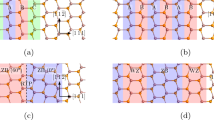Abstract
Extensive microstructural and structure-property studies on donor doped barium titanate have revealed that the PTCR phenomenon is strongly controlled by the density, number of grain boundaries available to conduction, domain orientation and grain boundary domain coherence. Structural heterogeneities lead to a wide range of grain boundary structures, potential barriers and, therefore, depletion widths. Conduction thus occurs primarily by percolation of electrons through favorably aligned domain pathways and low potential barrier grain boundaries. At the Curie point, the increase in the potential barriers along these pathways is likely to dominate the PTCR effect. To improve theoretical understanding a model needs to take heed of local values of parameters and also incorporate the fact that the bulk of the current flow is only through a certain percentage of grain boundaries. The specific structural factors that have led to an improved qualitative understanding of overall PTCR phenomenon are discussed.
Similar content being viewed by others
References
G. Goodman, J. Am. Cer. Soc., 46, 48 (1963).
W. Heywang, Solid State Electron., 3, 51 (1961).
G.H. Jonker, Solid State Electron., 7, 895 (1964).
J. Daniels and R. Wernicke, Philips Res. Repts., 31, 544 (1976).
B.M. Kulwicki and A.J. Purdes, Ferroelectrics, 1, 253 (1970).
R.D. Roseman, J. Kim, and R.C. Buchanan, Ferroelectrics, 177, 273 (1996).
R.D. Roseman, J. Kim, and R.C. Buchanan, Ferroelectrics, 177, 255 (1996).
R.D. Roseman, J. Kim, and R.C. Buchanan, Cer. Trans., 41, 153 (1994).
R.D. Roseman, Ferroelectrics, 215, 31 (1998).
G. Liu and R.D. Roseman, Ferroelectrics, 221, 181 (1999).
G. Liu and R.D. Roseman, J. Mat. Sci. Lett., 18, 1875 (1999).
N. Mukherjee, R.D. Roseman, and Q. Zhang, J. Phys. Chem. Solids, 63, 631 (2002).
M. Kuwabara, J. Am. Cer. Soc., 64, 639 (1981).
R.D. Roseman and R.C. Buchanan, in Procs. IEEE ISAF (Urbana, IL, 1992).
H.M. Al-Allak, G.J. Russell, and J. Woods, J. Phys. D: Appl. Phys., 20, 1645 (1987).
X. Ren and K. Otsuka, MRS Bull., 115 (Feb. 2002).
G.L. Sewell, Phys. Rev., 124, 597 (1963).
L. Friedman, Phys. Rev., 135, A233 (1964).
D. Emin, J.T. Devrees, and V.E. vanDoren, in Linear and Nonlinear Electron Transport in Solids (Plenum Press, New York).
I. Bunget and M. Popescu, in Physics of Solid Dielectrics, Materials Science Monographs, edited by C. Laird (Elsevier, 1984), vol. 19, p. 348.
B.A. Strukov and A.P. Levanyuk, in Ferroelectric Phenomena in Crystals (Springer, 1998), Ch. 10, p. 193.
J. Weertman and J. Weertman, in Elementary Dislocation Theory (Oxford University Press, 1992).
S.B. Desu and D.A. Payne, J. Am. Cer. Soc., 73, 3407 (1990).
C.N. Berglund and W.S. Baer, Phys. Rev., 157, 358 (1967).
S.I. Yakunin, V.V. Shakmanov, G.V. Spivak, and N.V. Vasil'eva, Soviet Physics-Solid State, 14(2), 310 (1972).
I.S. Zheludev, in Physics of Crystalline Dielectrics, edited by A. Tybulewicz (Plenum Press, New York, 1971), vol. 1.
J.S. Capurso, A.B. Alles, and W.A. Schulze, J. Am. Cer. Soc., 78(9), 2476 (1995).
J.S. Capurso and W.A. Schulze, IEEE ISAF, 731 (1994).
M. Kuwabara and K. Hamamoto, J. of Intelligent Material Systems and Structures, 10(6), 434 (2000).
M. Kuwabara, H. Matsuda, and K. Hamamoto, J. Am. Cer. Soc., 80(7), 1881 (1997).
Y. Chiang and T. Takagi, J. Am. Cer. Soc., 73, 3278 (1990).
B. Huybrechts and M. Takata, Key Eng. Matls., 111/112, 39 (1995).
E. Scholl, J. Appl. Phys., 60, 1434 (1986).
B.M. Kulwicki, J. Phys. Chem. Solids, 45, 1015 (1984).
N. Mukherjee and R.D. Roseman, Ferroelectrics, 281, 1 (2002).
G.D. Mahan, L.M. Levinson, and H.R. Philipp, Appl. Phys. Lett., 33, 830 (1978).
G.D. Mahan, L.M. Levinson, and H.R. Philipp, J. Appl. Phys., 50, 2799 (1979).
H.M. Al-Allak, J. Illingsworth, A.W. Brinkman, and J. Woods, J. Phys. D: Appl. Phys., 22, 1920 (1989).
P. Gerthsen and B. Hoffman, Solid-State Electron., 16, 617 (1973).
Author information
Authors and Affiliations
Rights and permissions
About this article
Cite this article
Roseman, R., Mukherjee, N. PTCR Effect in BaTiO3: Structural Aspects and Grain Boundary Potentials. Journal of Electroceramics 10, 117–135 (2003). https://doi.org/10.1023/A:1025647806757
Issue Date:
DOI: https://doi.org/10.1023/A:1025647806757




